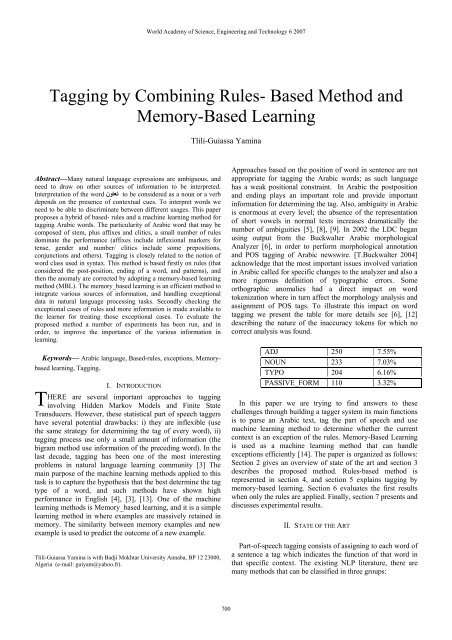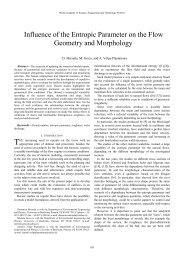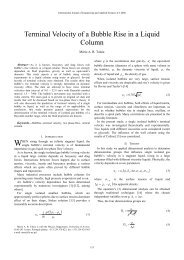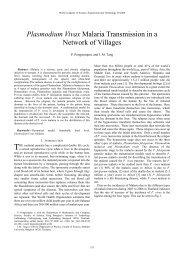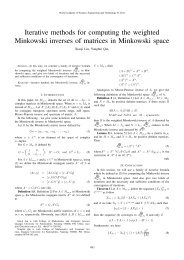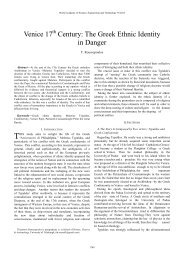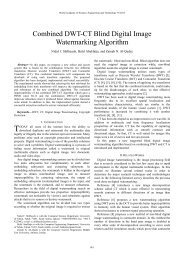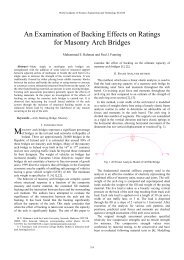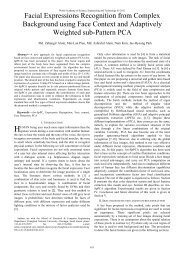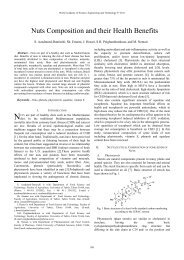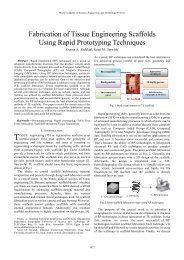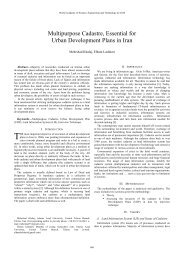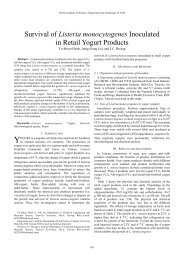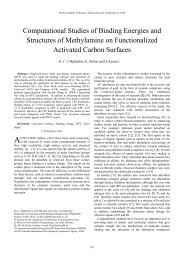Based Method and Memory-Based Learning - World Academy of ...
Based Method and Memory-Based Learning - World Academy of ...
Based Method and Memory-Based Learning - World Academy of ...
Create successful ePaper yourself
Turn your PDF publications into a flip-book with our unique Google optimized e-Paper software.
<strong>World</strong> <strong>Academy</strong> <strong>of</strong> Science, Engineering <strong>and</strong> Technology 6 2007--linguistic approach consists <strong>of</strong> coding the necessaryknowledge in a set <strong>of</strong> rules written by linguist(like the pioneerTAGGIT, Karlsson.1995, Voutilainen 1994),--statistical approach requires much less human effort,successful model during the last years Hidden Markov Models<strong>and</strong> related techniques have focused on building probabilisticmodels <strong>of</strong> tag transition sequences in sentence. Resultsproduced by statistical taggers are giving about 95%-97% <strong>of</strong>correctly tagged words. There are also, hybrid methods thatuse both knowledge based <strong>and</strong> statistical resources[Tzoukermann 1995],--The third family use learning algorithms that acquire alanguage model from a training corpus. Daelemans use anexample-based learning technique <strong>and</strong> a distance measure todecide which <strong>of</strong> the previously learned examples is moresimilar to the word to be tagged. The approach proposed by[Brill 92, <strong>and</strong> Brill 95] can be also considered as belonging tothis group, they learns automatically the series <strong>of</strong>transformations that best repair the most common errors madeby a tagger. There are also hybrid system which combinesh<strong>and</strong>-written constraint grammars with automatically Brill-likeerror-driven constraints[ Oflaze, Tur 1996]. Such methodshave shown relatively high performance in English, theseapproaches are based on local information(position <strong>of</strong> a word,tag <strong>of</strong> precedent words). More recently, Arabic tagger hasemerged with MULTEXT achieved a weak accuracy. In 2000smore researches used a tagset derived from Arabicgrammatical theory. ATP is a tagger that combines twomethods, statistical <strong>and</strong> rule-based techniques, <strong>and</strong> LDCtagger, it was developed by M. Maamouri <strong>and</strong> A. Bies[6] <strong>and</strong>achieved an accuracy <strong>of</strong> 96%. So, last decade is becomingincreasingly evident that statistical <strong>and</strong> corpus_basedapproaches, though necessary, are not sufficient to address allissues involved in building viable application in NLP [2].ΙΙΙ. HYBRID METHOD FOR TAGGINGA memory-based learning system contains two components:i) a learning component which memory storage is donewithout abstraction or restructuration. ii) a performancecomponent that does similarity-based classification.The idea, in the proposed method is to apply rules (analyzingthe affixes <strong>of</strong> the word <strong>and</strong> analyzing its patterns) to determinethe tag type <strong>of</strong> each word in a sentence <strong>and</strong> to refer tomemory-based to check whether it is an exceptional case, ornot. Applying rules to predicted a tag T i for a word W i , thepredicted tag T i is compared with the correct tag in the trainingphase. In case <strong>of</strong> no equality, it is considerate as an exception<strong>and</strong> the type <strong>of</strong> error is determined according to correct tag<strong>and</strong> the predicted tag. For each rule the number <strong>of</strong> exceptionalcases is stored in library. Figure 1 shows the structure <strong>of</strong> theArabic hybrid tagging model during classification. Firstly, therules are applied to determine the tag, <strong>and</strong> it is checked as anexceptional case <strong>of</strong> rules. Secondly, it is presented to memorybased reasoning, its similarity to all examples in memory iscomputed using a similarity metric, <strong>and</strong> the tag is determinedagain [4], [10]].ΙV. RULES-BASED TAGGINGThere are several signs in Arabic language that indicate thecategory <strong>of</strong> word. One <strong>of</strong> them is the affix. Some affixes areproper to verbs; some are proper to nouns; <strong>and</strong> some other areused with verbs <strong>and</strong> nouns. Another, important sign in Arabiclanguage is the pattern, which is an important guide inrecognizing the word category. Several grammatical rulesgives some signs to distinguish between type <strong>of</strong> word, <strong>and</strong>others signs are deduced from others features (number,gender, preposition, <strong>and</strong> conjunction...ect.) [9], [7], [5].During tagging process, the context <strong>and</strong> word form featuresare looked up for each word in the text. Information aboutsurrounding words is used, two words <strong>of</strong> the right context <strong>and</strong>two words <strong>of</strong> the left context [15], [10].V. MEMORY-BASED LEARNING<strong>Memory</strong>-based learning is a supervised classification-basedlearning method. A vector <strong>of</strong> feature values is associated witha class by a classifier that lazily extrapolates from nearestneighbours selected from all stored training examples.<strong>Memory</strong>-based learning is a direct descent <strong>of</strong> K-NearestNeighbour (K-NN) algorithm, it use complex data structure<strong>and</strong> different speedup optimization from the K-NN. Duringlearning a data base <strong>of</strong> instances is build with a memory-basedlearning algorithm IB1-IG [14]. An instance consists <strong>of</strong> afixed-length vector <strong>of</strong> n feature-value pairs, <strong>and</strong> aninformation field containing the classification <strong>of</strong> that particularfeature-value vector. The similarity between a new instance x<strong>and</strong> a memory instance y is computed with a distance metric∆(x,y). The tag <strong>of</strong> x is then determined by assigning the mostfrequent category within the k most similar example <strong>of</strong> x.( x, y)∆ = ∑ α i δ(x i ,y i )Where α i is the weight <strong>of</strong> i-th attribute <strong>and</strong>δ(x i ,y i ) = 0 if x i =y i= 1 if x i ≠y iDuring tagging process, the context <strong>and</strong> word form featuresare looked up for each word in the text. Information aboutsurrounding words is used, two words <strong>of</strong> the right context <strong>and</strong>two words <strong>of</strong> the left context [15], [10].VΙ. EVALUATIONOften it is stated that languages with a rich morphologyopen much more facilities for tagging [5]. The based- rulessystem after a segmentation phase [16] <strong>and</strong> extracting featuresgo through several tests; analyzing affixes <strong>and</strong> patterns <strong>of</strong>word <strong>and</strong> use a set <strong>of</strong> grammatical rules. Some examplesbelow show some results when only rules are applied (withambiguity).Example 1: - ُ جَمِيْلٌ is a word with same consonant string<strong>and</strong> same vowels but has different tags: application <strong>of</strong> ruleonly produce the same tag for both cases.NCSgMNI. must take the tag : جَمِيْلٌ here جَمِيْلٌ يَشْرُبُ -701
<strong>World</strong> <strong>Academy</strong> <strong>of</strong> Science, Engineering <strong>and</strong> Technology 6 2007جويٌ جَمِيلٌ -here tag: adjective must take the جَمِيْلٌ NACSgMNI.Another interesting point that we note here is that theapplication <strong>of</strong> only based-rules method, so very high numbers<strong>of</strong> words take an ambiguous tags.Example 2: - دَخلتْ بِنْتُ بِنْتُ is a noun, <strong>and</strong> cannot be h<strong>and</strong>ledcorrectly by the based-rules method <strong>and</strong> the word takes thetag: VPSg1.Initial results show the ambiguity rate is likely to be higherfor particles (Arabic language has a rich base <strong>of</strong> particles)when all possible particles are not present in the base. Some <strong>of</strong>them could be tagged as a noun when just the based-rulesmethod is applied.Example 3 : هَيهَات , …etc.مَا أَبْيضَ وَجهه :4 ExampleشَتَانResults also show that a very high number <strong>of</strong> adjectives cannot be h<strong>and</strong>led correctly by the based-rules method <strong>and</strong> can betagged as verbs.is an adjective but the word أَبْيضَis tagged as VPSg3M when only the based-rules method isapplied.Nouns in Arabic language that are not derived from roots aregoverned not only by phonological rules but by lexicalpatterns, that must be identified <strong>and</strong> stored for each noun [1].If only based-rules method is applied for this group <strong>of</strong> nouns(broken plurals) then is classified as singular.مَدَارس , 5: Exampleأَقلام, قصورdeterrmination(w 1 ,w 2 ,….w n )(T 1 , T 2 …T n °)rulesDeterminedcorrectlyendTrainingCategory <strong>of</strong>errorsAnomaly casesrulesW 1,W 2…..W n)T 1 , T 2 ,……T n )DeterminationCombinaisonclassificationWord, tagFig.1 Architecture <strong>of</strong> the Hybrid method for tagging: the decision <strong>of</strong> exceptional case is when the similaritybetween the context <strong>and</strong> the nearest instance in anomaly case is larger than some thresholdVΙ. RESULTSThe attempt to improve the performance <strong>of</strong> tagging processby checking the affix patterns, <strong>and</strong> uses a combination <strong>of</strong> affixrules, the patterns <strong>of</strong> the word <strong>and</strong> a set <strong>of</strong> grammatical rules.On the other h<strong>and</strong>, the use <strong>of</strong> memory-based learning thatallows for an easy integration <strong>of</strong> different information sources(different information sources: context tags, words,morphology, pattern etc. are used by the similarity metric),<strong>and</strong> can h<strong>and</strong>le exceptions efficiently has a number <strong>of</strong>advantages over statistical POS tagger i)make the taggingprocess more robust, ii) both development time <strong>and</strong>processing speed are very fast, <strong>and</strong> iii) involves thedisambiguation <strong>of</strong> word on the basis <strong>of</strong> information comingfrom both sources. For the evaluation <strong>of</strong> the proposedapproach, all experiments are performed on texts extractedfrom educational books in first stage, <strong>and</strong> some Qur’anic textthat was tagged using a small tag set <strong>and</strong> being retagged withmore detailed tag set, Figure 2, <strong>and</strong> Figure 3 show someexperimental results. The tag set used is the tag set derivedfrom APT [11]. This tag set is proper to Arabic languagewhich is a very different from Indo-European languages. Sincethe tags in APT tag set is insufficient, we find useful to addsome other tags.702
<strong>World</strong> <strong>Academy</strong> <strong>of</strong> Science, Engineering <strong>and</strong> Technology 6 2007VΙΙ. CONCLUSIONThere are several problems in Arabic language (agglutinativeform, run-on word, free concatenation, <strong>and</strong> orthographicvariation), <strong>and</strong> each level calls a specific processing to resolveanomalies. This proposed approach allows a new method tolearn tagging Arabic by a combination <strong>of</strong> based-rules <strong>and</strong> amemory-based learning. The creation <strong>of</strong> efficient tools such asmorphological analyzer <strong>and</strong> part-speech tagging, ease <strong>and</strong>speed the annotation process. This approach is based onlinguistic rules, <strong>and</strong> the tag is verified by memory-basedlearning. <strong>Memory</strong>-based learning is an efficient method toh<strong>and</strong>le regularities, sub regularities <strong>and</strong> exceptions that can bemodelled uniformly. The improvement was made incliticization, disambiguation at the level <strong>of</strong> core word (nounadjective,noun-verb, noun-verb-adjective, <strong>and</strong> participles). Inmany instance for disambiguated token, the memory-basedlearning could compensate for the errors rules. Rule-basedsystem is quite easy to extend, maintain <strong>and</strong> modify. Suchmethod combined with memory-based learning involvedfilling the gaps in the lexicon, <strong>and</strong> modifying the POS tag setin order to meet the requirements <strong>of</strong> NLP tasks. The proposedapproach can also be applied to other NLP processing such aschunking.Fig.2 Results after application <strong>of</strong> the based-rules methodFig. 3 Results after application <strong>of</strong> the Hybrid <strong>Method</strong>REFERENCES[1] A.Goweder, M.Poesio, A.De Roeck, J.Reynolds,‘Identifying BrokenPlurals in Unvowelised Arabic Text’, ACL 2001. Arabic LanguageProcessing.[2] A. Farghali, ‘Computer Processing <strong>of</strong> Arabic Script-based Languages:Curent State <strong>and</strong> Future Directions’, Coling 2004, Work Shop onComputational Approaches to Arabic Script-based Language, Geneva,Switzerl<strong>and</strong>, August 28, 2004.[3] A.Roberts, ‘Machine <strong>Learning</strong> in Natural Language Processing’,www.comp.Leeds.ac.uk , October 16, 2003.[4] J. Zavrel & Walter.Daelemans, ‘Recent Advances in <strong>Memory</strong>-<strong>Based</strong>Part-<strong>of</strong>-Speech Tagging’, Induction <strong>of</strong> Linguistic Knowledge TSL 2000.[5] M. Van Mol, ‘The semi-automatic tagging <strong>of</strong> Arabic corpora’, TheDutch language Union, Amsterdam, Bulaaq, 2001.[6] M. Maamouri & Ann Bies, ‘ Developing an Arabic Treebank: <strong>Method</strong>,Guidelines, Procedures, <strong>and</strong> Tools’, Coling 2004, Workshop onComputational Approaches to Arabic Script-based Language, Geneva,Switzerl<strong>and</strong>, August 28, 2004.[7] M. Diab & Kadri.Hacioglu & Daniel Jurafsky, Automatic Tagging <strong>of</strong>Arabic Text: From Raw Text to Base Phrase Chunks, The NationalScience Foundation, USA, 2004.[8] S. Abuleil & K. Alsamara & Martha.Evens, ‘Acquisition System forArabic Noun Morphology’, Computer <strong>and</strong> Humanities 36(2):191-221,May 2002.[9] Saleem.Abuleil & Martha.Evens, ‘Discovering Lexical Information byTagging Arabic Newspaper Text’, Workshop on Semitic LanguageProcessing. COLING-ACL’98.[10] T. Buckwalter. 2002. Buckwalter Arabic Morphological AnalyzerVersion 1.0. Linguistic Data Consortium, Catalog number LDC2002L49 <strong>and</strong> ISBN 1-58563-257-0, http://www.ldc.upenn.edu .703
<strong>World</strong> <strong>Academy</strong> <strong>of</strong> Science, Engineering <strong>and</strong> Technology 6 2007[11] Seong-Bac.Park & Byoung-Tak.Zhang, ‘Text Chunking by CombiningH<strong>and</strong>-Crafted Rules <strong>and</strong> <strong>Memory</strong>-<strong>Based</strong> <strong>Learning</strong>’, Proceedings <strong>of</strong> the41st Annual Meeting <strong>of</strong> the Association for Computational Linguistics,July 2003, pp 497-504.[12] S. Khoja, R.Garside, G.Knowles, ‘A tagset for the morph syntactictagging <strong>of</strong> Arabic’,http://www.comp.lancs.au.uk/computing/users/khoja/cl2001.pdf .[13] T. Buckwalter, ‘Issues in Arabic Orthography <strong>and</strong> MorphologyAnalysis’, Coling 2004, Workshop on Computational Approaches toArabic Script-based Language, Geneva, Switzerl<strong>and</strong>, August 28, 2004.[14] Valli.André & Jean.Veronis, ‘Etiquetage grammatical des corpus deparole : problèmes et perspectives’,http://www.up.univ-mrs.fr/~veronis/pdf/1999rfla.pdf[15] W. Daelemans & Antal van den.Bosch & Jakub.Zavrel & Jorn.Veenstra& Sabine.Buchholz & Bertjan.Busser , ‘Rapid Development <strong>of</strong> NLPModules with <strong>Memory</strong>-based Learnig’, Proceeding <strong>of</strong> ELSNET inWonderl<strong>and</strong>, March 1998, pp105-113.[16] W. Daelemans & Jakub.Zavrel, ‘Part-<strong>of</strong>-Speech Tagging <strong>of</strong> Dutch withMBT’ Informatiewetenschap 1996, pp 33-40, The Netherl<strong>and</strong>s.TU Delft.[17] Young-suk.Lee, Kishore Papineni, Salim.Roukos, ‘Langage Model<strong>Based</strong> Arabic Word Segmentation’, www.acl.ldc.upenn.edu .704


